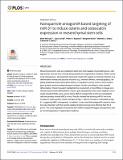Nanoparticle-antagomiR based targeting of miR-31 to induce osterix and osteocalcin expression in mesenchymal stem cells
Author(s)
McCully, Mark; V. Baptista, Pedro; Mullin, Margaret; Dalby, Matthew J.; Berry, Catherine C.; Osorio De Castro Conde, Joao; ... Show more Show less
Downloadjournal.pone.0192562.pdf (13.15Mb)
PUBLISHER_CC
Publisher with Creative Commons License
Creative Commons Attribution
Terms of use
Metadata
Show full item recordAbstract
This is an open access article distributed under the terms of the Creative Commons Attribution License, which permits unrestricted use, distribution, and reproduction in any medium, provided the original author and source are credited. Mesenchymal stem cells are multipotent adult stem cells capable of generating bone, cartilage and fat, and are thus currently being exploited for regenerative medicine. When considering osteogenesis, developments have been made with regards to chemical induction (e.g. differentiation media) and physical induction (e.g. material stiffness, nanotopography), targeting established early transcription factors or regulators such as runx2 or bone morphogenic proteins and promoting increased numbers of cells committing to osteo-specific differentiation. Recent research highlighted the involvement of microRNAs in lineage commitment and terminal differentiation. Herein, gold nanoparticles that confer stability to short single stranded RNAs were used to deliver MiR-31 antagomiRs to both pre-osteoblastic cells and primary human MSCs in vitro. Results showed that blocking miR-31 led to an increase in osterix protein in both cell types at day 7, with an increase in osteocalcin at day 21, suggesting MSC osteogenesis. In addition, it was noted that antagomiR sequence direction was important, with the 5 prime reading direction proving more effective than the 3 prime. This study highlights the potential that miRNA antagomiR-Tagged nanoparticles offer as novel therapeutics in regenerative medicine.
Date issued
2018-02Department
Institute for Medical Engineering and Science; Harvard University--MIT Division of Health Sciences and TechnologyJournal
PLOS ONE
Publisher
Public Library of Science
Citation
McCully, Mark et al. “Nanoparticle-antagomiR Based Targeting of miR-31 to Induce Osterix and Osteocalcin Expression in Mesenchymal Stem Cells.” Edited by Hélder A. Santos. PLOS ONE 13, 2 (February 2018): e0192562 © 2018 McCully et al
Version: Final published version
ISSN
1932-6203